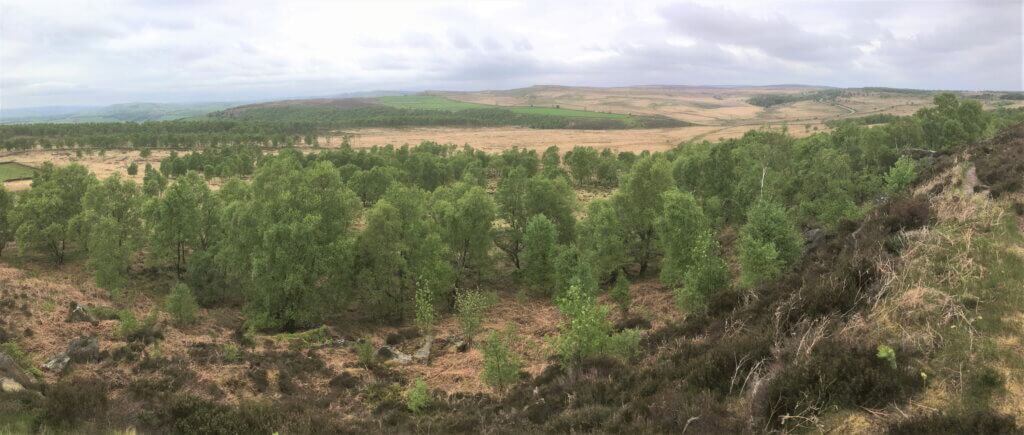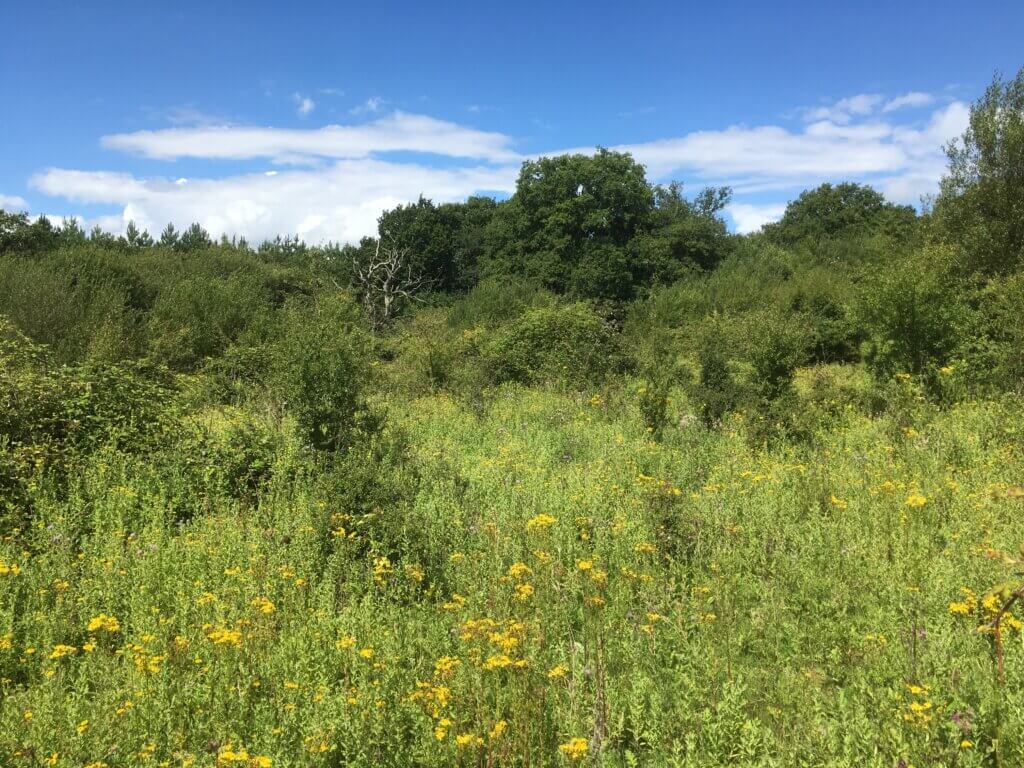
Natural regeneration key to doubling woodlands and saving Britain’s crippled forests
Government’s draft England Tree Strategy ‘woefully inadequate’
Allowing trees to naturally establish over huge areas could massively expand Britain’s woodlands more effectively and at a fraction of the cost of tree planting, according to research by Rewilding Britain.
It says the Government’s draft England Tree Strategy, open for public consultation to 11 September, is woefully inadequate for tackling the climate and nature crises. More ambitious targets and a fresh approach are needed.
With Britain one of Europe’s least wooded countries, Rewilding Britain supports a doubling of the country’s woodland cover over the next decade, from 13 percent now to at least 26 percent. This could help absorb 10 percent of current UK greenhouse emissions annually, and help declining wildlife.
But the Government’s draft strategy for reforestation in England fails to set any tree targets, and at best would raise English woodland cover from 10 percent today to just 12 percent by 2050.
The Government’s unambitious plans also focus on manual tree planting as a quick fix. But a Rewilding Britain study to be published later this year shows that allowing and enhancing natural regeneration – supported by native tree planting in suitable sites – would be the most effective long-term approach for landscape-scale reforestation.
“We urgently need an expansion of nature’s recovery across Britain that matches the scale of the threats from accelerating climate heating and species extinction – with clear and bold targets from the Government,” said Rebecca Wrigley, Rewilding Britain’s Chief Executive.
“We can’t replace our lost woodlands by planting alone. Protecting ancient woodland fragments, and allowing and assisting trees to naturally regenerate on a big scale, is the most effective way of reversing the sorry fortunes of our crippled forests and woodlands, and so benefiting people, nature and the climate.”
Letting trees and shrubs naturally regrow over much of their former landscapes – with a helping hand where needed, such as preparing the ground when necessary or sowing tree seeds when naturally available seed sources are too far away – would create woodlands better able than plantations to soak up carbon dioxide, support wildlife, and adapt to a changing climate. Costs and management, imported tree diseases, and plastic tree guards would all be reduced.
A doubling of Britain’s woodland cover would include areas of land over which young trees are naturally establishing, and which will grow into the forests and wildwoods of the future.

Major barriers to natural regeneration are attitudes towards scrub – a superb habitat and nursery for young trees, but often seen as a waste of space or untidy – and over-grazing of trees by herbivores.
The Government’s new Environmental Land Management Scheme should address these challenges by offering landowners financial incentives for allowing natural regeneration of trees – avoiding the pitfalls of previous schemes which penalised landowners for unmanaged areas – and support marginal upland farming in shifting from low-productivity sheep and deer ranching to rewilding.
To double Britain’s woodland cover, the Government should raise annual investment from £50 million now to at least £500 million. Economic benefits would include jobs in forestry, tourism and ecosystem restoration. The many benefits of trees – carbon drawdown and storage, flood mitigation, urban cooling, improved soil and water quality, and wildlife habitat – far outweigh such upfront costs.
Rewilding Britain says natural regeneration of woodlands should be part of broader rewilding – the large-scale restoration of nature by letting it take care of itself. This includes better protection for ancient woodlands, and ensuring a diverse mix of better-connected habitats.
Evidence from around the world highlights the benefits of natural regeneration. In Eastern Europe and the former USSR, vast spontaneous reforestation since the Soviet Union’s collapse includes most of over 58 million hectares of abandoned croplands in Russia and Kazakhstan.
Flourishing broadleaved forests in coastal southern Norway – once as deforested and bare as much of Britain today – demonstrate how natural regeneration might happen in upland areas like Cumbria without intense grazing pressure and detrimental management such as moorland burning.
Evidence from Friends of the Earth shows there is more than enough suitable land to double England’s tree cover, without affecting precious habitats such as peatlands or valuable farmland.
“Our ancient woodlands are only absent because we’ve destroyed them and continue to work hard to prevent their return through over-cutting, over-mowing and over-grazing. If we let them, millions of trees would plant themselves across most of Britain,” said Rebecca Wrigley.

For more details and to comment on the Government’s draft England Tree Strategy, see rewildingbritain.org.uk/blog/tree-strategy.
Rewilding Britain wants rewilding to flourish – to tackle the climate and extinction crises, reconnect people with nature, and inspire people through new opportunities.
Ends
[registration_form]
Good for Rewilding Britain to point out what a pathetic approach this Government is adopting. A five year old school child I am sure could do a lot better. Also we must include our blanket bogs and peatlands which contain and absorb huge amounts of CO2, much more than our woodland Where are the Government’s proposals for these ? Very probably there won’t be any, as any proposals for repairing, protecting and enhancing our blanket bogs and peatlands would hurt their friends in the shooting industry and that would never do.
So this Government is presiding over another farce namely talking about planting a few scrappy trees which won’t significantly absorb CO2 for another thirty years or so, while totally ignoring the big absorbers, the peatlands and blanket bogs all for the sake of protecting an antediluvian shooting industry which should have been banned a long time ago.
Protecting / restoring peat bogs best of all.
Of course, as money is the only thing this government cares about (HS2, ‘lets get Britain flying again’, grouse shooting etc) their thought is no doubt that planting trees involves human work (i.e. jobs), unlike most natural regeneration.
How to save the planet: consume less, have fewer children. Simples.
HALLALULAH, at long last someone in this self-centred, money-grabbing conservation industry fiasco who understands what’s going on, what a difference between Rebecca and the incompetent idiots on this blog, in the media and in the charities who wants to plant non-native conifers all over the place.
For those interested in re-wilding in general, there’s an excellent article on Derek Gow in today’s Guardian: https://www.theguardian.com/environment/2020/sep/04/its-going-to-be-our-way-now-the-guerrilla-rewilder-shaking-up-british-farming-aoe
A typically candid comment by Gow on the future of his own re-wilding project: “I don’t know what it’s going to look like but there will be a shit tonne more life.” Just brilliant.
Fantastic stuff! The now traditional community tree planting exercise is typically a numbers game – how many can you squeeze in a limited area. Loads of trees of a very few species planted very, very closely together in plastic tubes. A few yeas later you get a thicket of very spindly young trees too underdeveloped too hold a bird’s nest, but that cast a shade too dark for ground flora and the lots of slowly disintegrating plastic tubes forgotten about or out of reach. I see this again and again and it’s utter crap. We need to be planting woods rather than trees – a wider range of native trees and shrubs, ground flora plugs and seeds, climbers like ivy and honeysuckle, creation of habitat piles and introduction of dead wood. Miyawaki ‘forests’ look like an interesting alternative and we might be pushing for one in an urban area here in autumn 2021 https://forestcreators.com/miyawaki-method/. The ignorance about scrub is another priority issue that needs tackling, far too often you hear that we need lots of sheep or even deer to stop the hills from being covered in ‘SCRUB!!!’ as if it’s a form of plague. Incredibly silly as scrub can turn into woodland and the beloved hedgerow is nothing more than scrub in continuous linear form – the public needs this pointed out to them.
This seems the way forward, with, as stated, a helping hand where
needed.
Some areas, as shown in the top photo, could end up an even aged
monoculture for many years, whereas with some selective thinning,
and introduction of species from as close as is practical, a rapid transformation could be achieved.